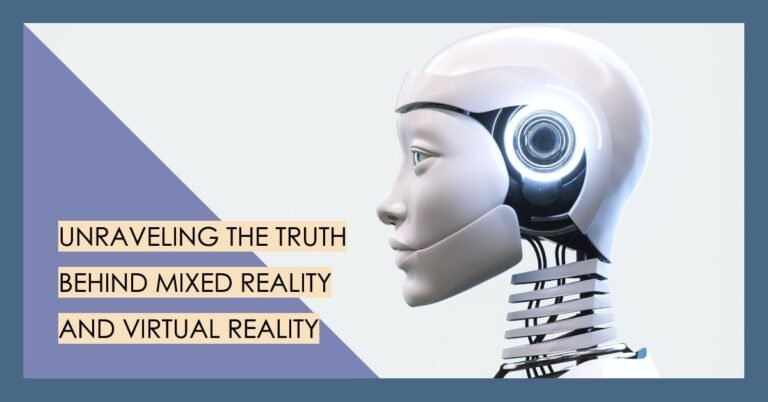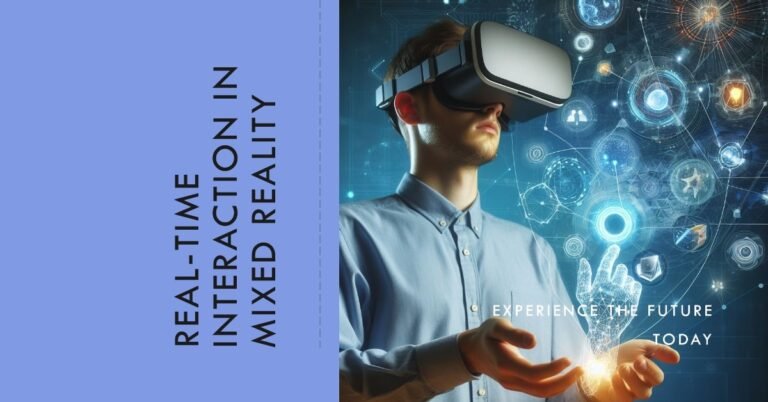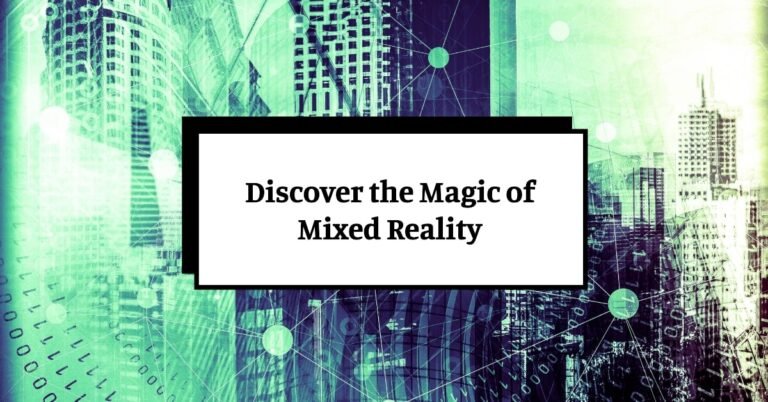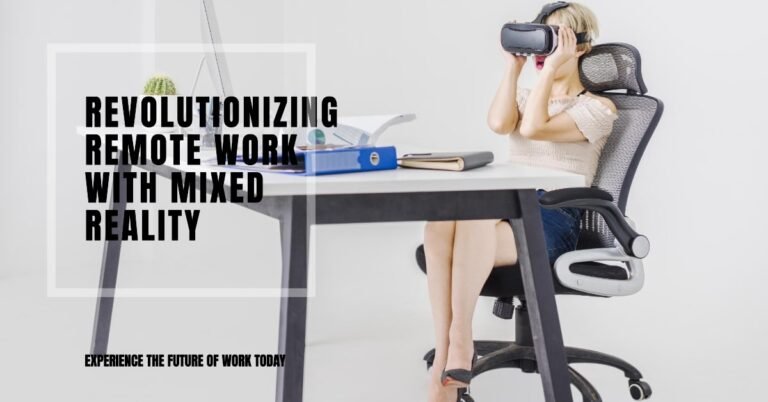How Does Mixed Reality Expand On Augmented Reality?
How Does Mixed Reality Expand On Augmented Reality? Remember that time you saw a dinosaur towering over your living room coffee table through your phone’s AR app? Pretty cool, right? Well, that’s just a taste of what the world of augmented reality (AR) has to offer. But what if I told you there’s an entire layer of interactivity waiting to be explored? That’s where mixed reality (MR) comes in, pushing the boundaries of what’s possible and making AR look like child’s play.
Now, you might be wondering, how does mixed reality expand on augmented reality? Buckle up, fellow tech adventurer, because on ARVRRealm, we’re about to embark on a journey to uncover the secrets of this mind-blowing technology.
In a nutshell, here’s the key difference: AR overlays digital information onto the physical world, while MR seamlessly integrates virtual objects into your environment, allowing you to interact with them as if they were real.
Think about it this way: Imagine playing chess with a holographic hologram on your coffee table, or virtually dissecting a frog in your biology class. That’s the kind of immersive experience MR brings to the table (pun intended).
How Does Mixed Reality Expand On Augmented Reality?
AR has taken the world by storm, but MR offers a whole new level of engagement. Here’s a breakdown of How Does Mixed Reality Expand On Augmented Reality:
- Interaction with Virtual Objects: Unlike AR’s static overlays, MR allows you to manipulate virtual objects in real time. You can pick them up, move them around, and even collide them with physical objects, creating a whole new level of engagement. Imagine a car mechanic using MR to virtually disassemble an engine or an architect manipulating a 3D model of a building right on the construction site.
- Spatial Awareness: AR content often feels disconnected from the real world. MR systems are equipped with advanced sensors like depth cameras and LiDAR that map out your surroundings in real time. This allows virtual objects to respond to their physical environment. For instance, a virtual chair you place on the floor in MR won’t magically float in mid-air – it’ll rest on the ground just like a real chair would. This creates a sense of presence and realism that AR simply can’t replicate.
- Beyond the Screen: AR is often limited to smartphone and tablet screens. These screens act as a window into the augmented world, but they can also be a barrier to immersion. MR, on the other hand, utilizes headsets and other specialized displays, completely immersing you in the mixed reality experience. It’s like stepping into a whole new world, not just viewing it through a tiny window. Imagine the difference between watching a movie on your phone and being transported right into the heart of the action. That’s the power of MR.
- The Power of Blending Worlds: MR truly merges the physical and digital, creating a cohesive and interactive experience. Imagine a surgeon practicing a procedure on a virtual patient overlaid on a real human body. Or an architect visualizing a new building design right on the construction site, with virtual walls seamlessly blending into the existing physical landscape. The possibilities are truly endless, and MR allows us to bridge the gap between the physical and digital in a way that AR simply can’t.
How MR is Transforming Industries
Now that we understand how mixed reality expands on augmented reality, let’s see how it’s impacting different fields:
- Education: Imagine dissecting a frog in biology class without harming a single creature, or exploring the pyramids of Egypt from the comfort of your classroom. MR can revolutionize education by making learning interactive, engaging, and accessible. Students can manipulate 3D models of historical artifacts, virtually travel to different parts of the world, and even perform complex experiments in a safe and controlled environment.
- Healthcare: MR can be a game-changer in surgery, allowing doctors to visualize procedures beforehand and even overlay vital patient information during operations. Imagine a surgeon wearing an MR headset that displays a 3D model of the patient’s anatomy, highlighting critical structures and potential risks. This level of precision can lead to safer and more effective surgeries. Additionally, MR can be used for physical therapy, creating virtual environments for patients to practice rehabilitation exercises or for phobia treatment, exposing patients to their fears in a controlled setting.
- Manufacturing and Design: Architects can use MR to create 3D models of buildings and walk through them virtually before construction even begins. This allows them to identify potential issues early on and make necessary adjustments, saving time and money down the line. Similarly, engineers can use MR to design and test new products safely and efficiently. Imagine a car designer virtually manipulating a car’s engine in real time, identifying potential problems before a physical prototype is even built.
- Retail: Imagine trying on clothes virtually without stepping foot in a store, or visualizing how new furniture would look in your living room. MR has the potential to revolutionize the retail industry by creating a more personalized and interactive shopping experience. Customers can use MR apps to virtually try on clothes in different sizes and colors, or see how furniture would fit in their space before making a purchase. This can not only improve customer satisfaction but also reduce returns and increase sales.
- Entertainment: The world of entertainment is also ripe for disruption by MR. Imagine watching a movie where you can step into the scene, or attending a concert where the performers appear to be right in front of you. MR can create immersive gaming experiences that take players to entirely new worlds, blurring the lines between reality and fantasy.
MR vs. AR: Choosing the Right Tool for the Job
So, with all this talk about MR’s awesomeness, is AR obsolete? Not quite. Both technologies have their strengths and weaknesses. Here’s a quick comparison to help you decide which one is right for your needs:
Use AR for:
- Simple information overlays: AR excels at providing quick and easy access to information. Think about apps that display restaurant reviews overlaid on your phone’s camera as you point it at the establishment, or navigation apps that provide turn-by-turn directions overlaid on your windshield.
- Easy-to-access applications: AR applications are often readily available on smartphones and tablets, making them accessible to a wide audience. This low barrier to entry allows for a wider range of uses, from educational apps to productivity tools.
- Cost-effective solutions: Developing and deploying AR applications is generally less expensive compared to MR. This makes AR a more viable option for businesses and individuals with limited budgets.
Use MR for:
- Complex, interactive experiences: MR shines when it comes to creating complex and interactive experiences. The ability to manipulate virtual objects and respond to the physical environment opens doors for applications in fields like education, healthcare, and design.
- Tasks requiring spatial awareness and manipulation of virtual objects: If your project requires precise interaction with virtual objects in a real-world space, then MR is the clear winner. Imagine an architect needing to design a building addition that seamlessly integrates with the existing structure. MR allows for this level of precision and spatial awareness.
- Industries like healthcare, engineering, and design: These industries can leverage MR’s capabilities to create efficiencies, improve safety, and enhance training. From surgeons practicing complex procedures to engineers designing new products, MR has the potential to revolutionize these fields.
The Future of Mixed Reality
Mixed reality is still in its early stages, but the future holds immense potential. As technology advances and costs decrease, we can expect to see MR become more widespread and integrated into our daily lives. Here are some exciting possibilities to look forward to:
- Ubiquitous MR headsets: Imagine a world where MR headsets are as commonplace as smartphones. These headsets could seamlessly blend the physical and digital worlds, providing us with constant access to information and interactive experiences.
- Enhanced communication and collaboration: MR can revolutionize the way we communicate and collaborate. Imagine attending virtual meetings where colleagues appear to be sitting right across from you in a shared virtual space, or working on design projects together in real time, even if you’re located in different parts of the world.
- Revolutionized education and training: MR can create immersive learning experiences that are not only engaging but also effective. Students can explore historical events, travel to different parts of the world, and even perform complex experiments in a safe and controlled environment. Similarly, MR can be used to train professionals in various fields, from surgeons to firefighters, providing them with realistic simulations of real-world scenarios.
- Blurring the lines between reality and entertainment: MR has the potential to transform the entertainment industry. Imagine attending concerts where the performers appear to be right in front of you, or playing video games where you’re completely immersed in the virtual world. MR can create experiences that are more interactive and engaging than anything we’ve ever seen before.
Frequently Asked Questions About Mixed Reality (MR)
What are the limitations of Mixed Reality?
While MR offers exciting possibilities, there are still some challenges to overcome. Here are a few limitations to consider:
Cost: Current MR headsets can be quite expensive, limiting accessibility for many users.
Processing Power: MR applications require significant processing power to function smoothly. This can be a hurdle for both developing MR experiences and ensuring users have compatible devices.
Battery Life: The processing power needed for MR experiences can drain battery life quickly. This can limit the amount of time users can spend in a mixed reality environment.
Content Availability: MR is a relatively new technology, and the content library is still growing. This means there may not be MR experiences available for all your needs yet.
Is Mixed Reality safe?
As with any new technology, there are some potential safety concerns with MR. Here are a few things to keep in mind:
Eye Strain: Spending extended periods in an MR headset can cause eye strain. It’s important to take breaks and follow recommended usage guidelines.
Motion Sickness: Some users may experience motion sickness when using MR, especially in experiences that involve rapid movement.
Physical Hazards: Since MR can immerse users in their surroundings, it’s important to be aware of your physical environment to avoid tripping or bumping into objects.
What are some ethical considerations for Mixed Reality?
As MR continues to develop, there are important ethical considerations to address. Here are a few questions to ponder:
Privacy: How will user data be collected and used in MR experiences?
Addiction: The immersive nature of MR could potentially lead to addictive behaviors.
Social Impact: How will MR affect our social interactions and sense of reality?
How can I get started with Mixed Reality?
If you’re interested in exploring MR, here are a few ways to get started:
Do your research: Learn more about the technology, different MR headsets available, and the types of MR experiences that interest you.
Try a demo: Many tech stores offer demos of MR headsets. This is a great way to experience MR firsthand and see if it’s right for you.
Start with AR: While not the same as MR, AR apps can give you a taste of what it’s like to interact with digital elements in the real world.
Stay informed: The world of MR is evolving rapidly. Keep up with the latest developments by reading articles, watching videos, and attending industry events.
Conclusion – How Does Mixed Reality Expand On Augmented Reality?
Mixed reality is more than just a technological advancement; it’s a paradigm shift. It’s about blurring the lines between the physical and digital worlds, creating new possibilities for learning, working, and playing. As MR continues to evolve, we can expect to see even more innovative applications emerge, transforming the way we interact with the world around us.
So, buckle up and get ready for a future where the boundaries between physical and digital are constantly being redefined. Remember that time you saw a dinosaur in your living room? In the world of MR, that dinosaur could be your virtual pet, following you around the house and responding to your voice commands. The possibilities are truly endless, and it’s an exciting time to be alive and witness the birth of this groundbreaking technology.
Are you curious to learn more about mixed reality? Here on ARVRRealm, we’re constantly diving deeper into the world of MR. Explore our website for articles on the latest MR developments, reviews of upcoming headsets, and insights into how MR is shaping different industries. Let’s embark on this journey of discovery together and unveil the magic of mixed reality!







One Comment